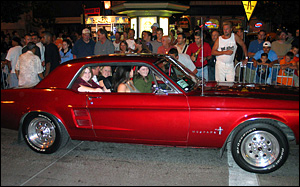
Center for Problem-Oriented Policing
The Problem of Cruising
This guide begins by describing the problem of cruising, and reviewing factors that contribute to it. It then identifies a series of questions to help you analyze your local cruising problem. Finally, it reviews responses to the problem, and what is known about them from evaluative research and police practice.
You should note that while both cruising and street racing involve vehicles, some primary differences exist between them. Cruising is a pastime largely confined to downtown areas; sanctioned cruising can also provide an economic boost to the community.† Conversely, street racing is typically an underground affair, causing many related problems.
† For example, northern Nevada's weeklong "Hot August Nights" event generated $132 million for the cities of Reno and Sparks, with more than 800,000 people attending (RRC Associates 2003).
The simplest definition of cruising is "unnecessary repetitive driving."1 Attempts to legally define cruising have been more difficult, however, as people have successfully challenged anti-cruising ordinances in court on constitutional grounds.
Since at least the 1950s, people have cruised for a variety of reasons: to show off their own car, to see other people's cars, to find racing competitors, to impress members of the opposite sex, and to socialize.2 Reinvigorated and glamorized by popular films such as American Graffiti, cruising remains an enormously popular rite of passage for many young people.3 Today's cruisers drive a variety of vehicles: classic cars, pickup trucks, mini-trucks, muscle cars, lowriders (whose chassis narrowly clear the ground), and even motorcycles. Cruisers are particularly prevalent on Friday and Saturday nights, and they can number in the thousands.

But cruising is not purely harmless fun. It creates problems for the police, nonparticipating motorists, some businesses, and the community at large. Among them are
- Conflicts between cruisers (including gang-related violence)
- Littering
- Noise (from vehicle engines, screeching tires, car stereos, and exuberant fans)
- Traffic congestion (including obstruction of emergency vehicles)
- Traffic crashes
- Vandalism and unintentional property damage.
While cruising creates business for some merchants, it impedes business for others.
In some jurisdictions, cruisers have divided up along racial, ethnic, and subcultural lines: blacks, Hispanics, punkers and heavy metal groups, the cowboy/western set, and so forth. Sometimes these divisions lead to group conflicts and violence, causing injury to participants and innocent bystanders and heightening fear in the wider community.4 In some jurisdictions, cruising has taken on a "rock concert" environment in which disorder, violence, and police enforcement are integral to the experience, and even expected and desired by the participants.5
Related Problems
There are several cruising-related problems police must also address. These call for separate analyses and responses, and are not directly addressed in this guide:
- Assaults
- Auto theft
- Curfew violations
- Display of pornographic videos on vehicle-mounted televisions
- Drug dealing
- Drunken driving
- Gang-related activity
- Littering
- Loitering
- Loud car stereos
- Noise (including illegal use of amplifiers,6 which can activate burglar alarms7),
- Street racing
- Traffic gridlock
- Traffic violations and crashes
- Underage drinking
- Vandalism.

Factors Contributing to Cruising
Understanding the factors that contribute to your problem will help you frame your own local analysis questions, determine good effectiveness measures, recognize key intervention points, and select appropriate responses.
Since the 1940s, teenagers have had easier access to cars, and cruising has become a popular pastime. Everyone used to meet at drive-in restaurants. Two drive-in restaurants often anchored the ends of a cruise route where cars would "drag." Although there has been widespread closing of drive-ins since the 1970s, young people still find places to cruise.
Cruising remains popular for many reasons:
- It appears to be unsupervised.
- It gives people who are too young to go to bars or engage in other adult-only activities something to do (especially in cities that lack alternatives to cruising).
- It provides a means to socialize.
- It allows people to show off their vehicles and driving ability.8
- It lets people express racial and cultural pride (in locales where racial and ethnic identity is linked to the cruising phenomenon).
- Cars are a big part of American culture, and people value the freedom of the open road and the notion that one should be able to drive wherever one wants, whenever one wants.9
Free Bound Copies of the Problem Guides
You may order free bound copies in any of three ways:
Online: Department of Justice COPS Response Center
Email: [email protected]
Phone: 800-421-6770 or 202-307-1480
Allow several days for delivery.
Email sent. Thank you.
Cruising
Send an e-mail with a link to this guide.
* required
Error sending email. Please review your enteries below.
To *
Separate multiple addresses with commas (,)
- Your Name *
Your E-mail *
Copy me
Note: (200 character limit; no HTML)
Please limit your note to 200 characters.